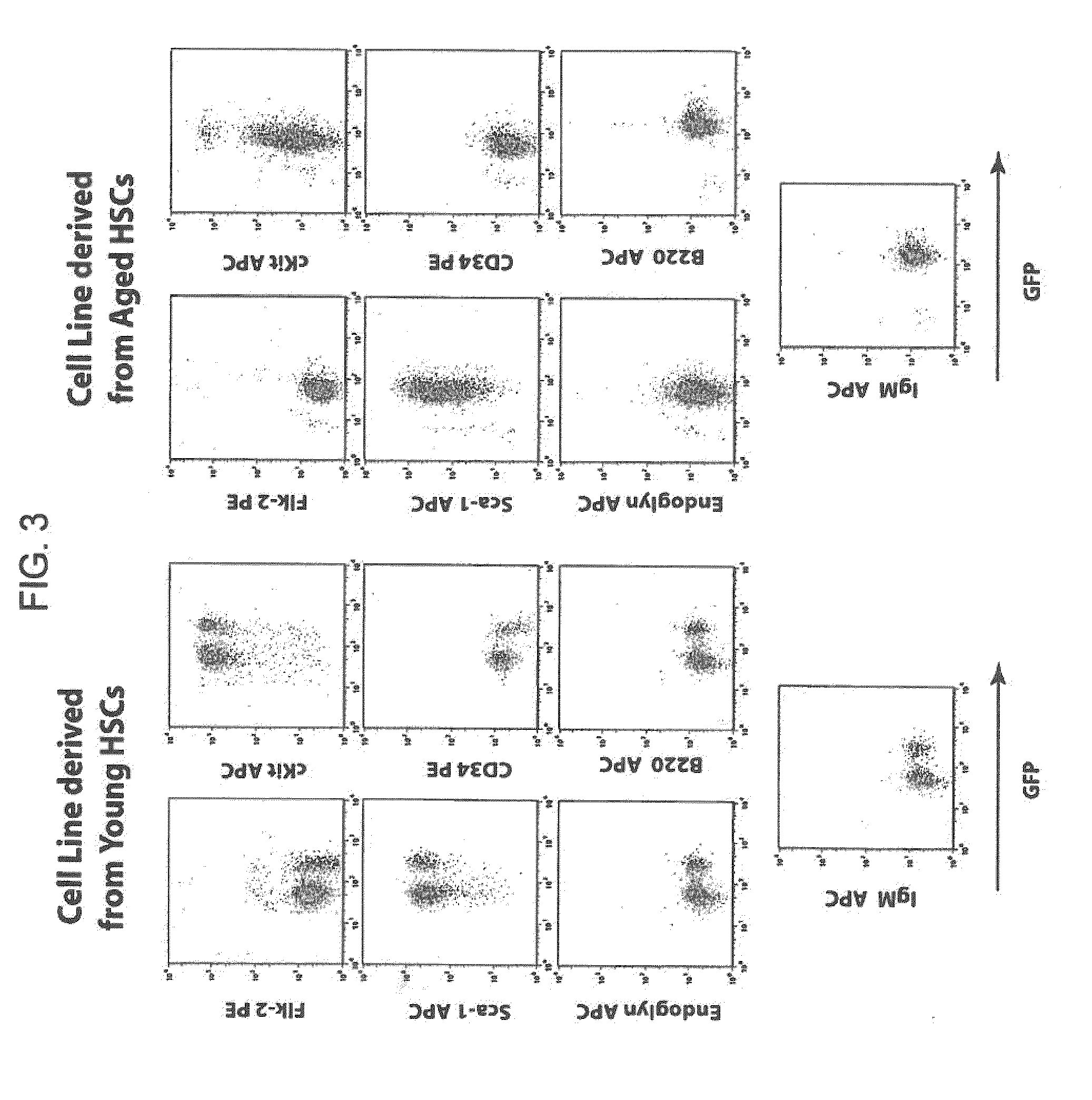Conditionally immortalized long-term stem cells and methods of making and using such cells
a long-term stem cell, conditionally immortalized technology, applied in the direction of genetically modified cells, peptide sources, immunological disorders, etc., can solve the problems of limited availability of long-term hematopoietic stem cells (lt-hscs), major limiting factor in all studies of hematopoiesis, and major obstacles in treatment, so as to promote cell survival and proliferation, and inhibit apoptosis of cells
- Summary
- Abstract
- Description
- Claims
- Application Information
AI Technical Summary
Benefits of technology
Problems solved by technology
Method used
Image
Examples
example 1
[0153]The following example describes the development of a method to reversibly immortalize long-term hematopoietic stem cells (lt-HSCs).
[0154]Elucidation of the molecular basis of the impairment in hematopoietic lineage development has been complicated historically by the low frequency of relevant cell populations, which prevents biochemical analysis of signaling and downstream responses. In fact, this has been a major limiting factor in all studies of hematopoiesis. In addition, the limited availability of LT-HSCs has also been a major obstacle in the treatment of many types of cancer as well as several kinds of immune deficiencies in humans.
[0155]In an effort to overcome this limitation, the present inventors developed a method to produce conditionally transformed cell lines representing early hematopoietic stem cell progenitors. The initial strategy involved retroviral transduction of bone marrow stem cells from 5FU treated young and immunologically aged 3-83 mice. The inventors...
example 2
[0161]The following example describes the results of adoptive transfer of LT-HSC lines into lethally irradiated recipients.
[0162]If the HSC lines described in Example 1 are to be appropriate subjects for analysis of the basis of defective B cell lymphopoiesis in aged animals, they should recapitulate the defect in vivo. The inventors have begun to address this question by adoptive transfer of LT-HSC lines into lethally irradiated recipients. In initial experiments, lines from aged animals (>60% ID−) were transferred along with RAG2− / − bone marrow, and recipients were not treated with tamoxifen in order to silence MYC-ER. Six weeks later recipient bone marrow and spleen cells were harvested and the recovery and phenotype of GFP+ cells (GFP marks cells derived from HSC lines) was analyzed (FIG. 5).
[0163]In the data from three mice presented in FIG. 5, one mouse received the aged HSC line ABM42, and two mice received aged HSC line ABM46. Depending upon the line transferred, 30 to 70% o...
example 3
[0165]The following example describes a method for reversibly immortalizing HSCs using a method conducted entirely in vitro.
[0166]In addition to the method for generating conditionally immortalized long term HSC cell lines described previously herein, the inventors have been able to carry out this procedure completely in vitro. The method described above relies upon introducing the transduced HSC's into mice, and inducing their transformation in vivo. The advantage of carrying this procedure out in vitro is that every aspect of the process is carried out in a controlled environment.
[0167]The method first includes the treatment of donor mice with 5-fluorouracil (5-FU) in order to enrich for HSCs and induce these cells to proliferate. 5FU enriched hematopoietic stem cells from the tibia and femurs of mice were collected and then plated in 24 well tissue culture plates in DMEM media containing 15% heat inactivated fetal calf serum and IL-3, IL-6 and SCF, at a density of 1.8-2.0×106 cel...
PUM
| Property | Measurement | Unit |
|---|---|---|
| melting temperatures | aaaaa | aaaaa |
| temperature | aaaaa | aaaaa |
| temperature | aaaaa | aaaaa |
Abstract
Description
Claims
Application Information
 Login to View More
Login to View More - R&D
- Intellectual Property
- Life Sciences
- Materials
- Tech Scout
- Unparalleled Data Quality
- Higher Quality Content
- 60% Fewer Hallucinations
Browse by: Latest US Patents, China's latest patents, Technical Efficacy Thesaurus, Application Domain, Technology Topic, Popular Technical Reports.
© 2025 PatSnap. All rights reserved.Legal|Privacy policy|Modern Slavery Act Transparency Statement|Sitemap|About US| Contact US: help@patsnap.com



